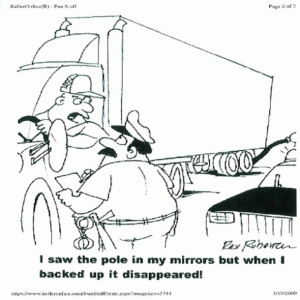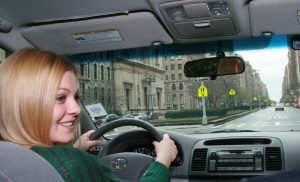Avoid Backing Incidents
 Backing incidents can account for up to half of all reportable fleet incidents.
Backing incidents can account for up to half of all reportable fleet incidents.
Virtually all backing collisions are preventable though. We drive in reverse only a fraction of the distance that we go in the forward direction, yet it seems that backing is a serious problem in most fleets.
Leader Tip: Check and note your organization’s percentage of incidents associated with backing.
The Question for this Meeting:
Why do you think there are so many backing incidents?
Answers may be:
■ Driver is unskilled at backing.
■ Visibility is poor and it’s therefore easier to miss seeing a hazard.
■ Driver is in a hurry and fails to take the time to ensure no hazards.
■ Driver didn’t use a guide.
■ Driver was backing in a situation where it could have been avoided.
■ Driver was going too fast to properly control vehicle.
■ Driver failed to walk around to check for hazards.
■ Other reasons?
Backing incidents at best are expensive but at worst can end up as fatalities. Not only on the job, but also at home! Across North America, every year, over 250 children are killed in the driveways of their own homes, in back over incidents where a parent, relative or friend backs up while the child is behind the vehicle and can’t be seen. Even if you don’t have small children of your own, are there any kids in your neighbourhood?
How many of us have jumped into the car or truck and just backed out of the driveway without looking behind first?
How many have run over a bicycle or child’s toy in the driveway?
Tailgate Tips:
7 Tips to Avoid Backing Incidents
1. Avoid Backing
– Find a spot to pull through to park.
– Back in when you have to stall park to allow your first move to be forward.
2. Circle Check
– If your vehicle has been parked for a while, walk around before moving it to make sure that there are no hazards that you are unaware of.
3. Look Back
– Either look out the centre of the rear window by turning in your seat or adjust and use your mirrors effectively.
4. Back Slowly
– Keep your speed to a walking pace maximum to ensure that you can control the vehicle and react to problems if they arise.
5. Use a Guide
– If there is a reliable person who can help guide you back, USE THEM! Agree on signals before starting back and keep them in sight. Stop if you lose sight of your guide.
6. Avoid Distractions
– As with any driving, avoid use of mobile devices, radios or other electronics when backing.
7. Practise
– We back-up infrequently and many of us don’t have a high level of confidence. If you are unsure of your ability, take some time and practise. Set up some cones to back around or just find a quiet parking lot and practise backing into empty stalls.


 A new online practice quiz is now available on ICBC’s main web site (icbc.com) to help reduce the most common errors that drivers make when taking their road test.
A new online practice quiz is now available on ICBC’s main web site (icbc.com) to help reduce the most common errors that drivers make when taking their road test. As of January 7, 2013, upon qualification of a BC Driver’s Licence, customers possessing a Non-Reciprocal driver licence must surrender it to an ICBC Driver Licensing Office. The public and law enforcement will be given 90 days notice.
As of January 7, 2013, upon qualification of a BC Driver’s Licence, customers possessing a Non-Reciprocal driver licence must surrender it to an ICBC Driver Licensing Office. The public and law enforcement will be given 90 days notice.